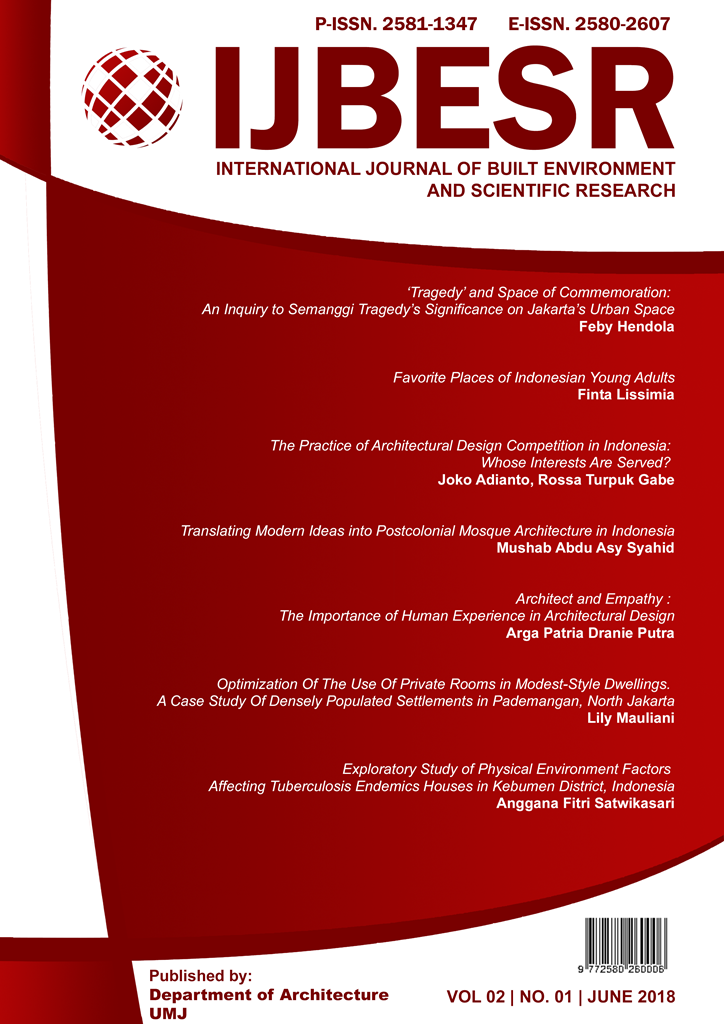‘Tragedy’ and Space of Commemoration: An Inquiry to Semanggi Tragedy’s Significance on Jakarta’s Urban Space
DOI:
https://doi.org/10.24853/ijbesr.2.1.1-14Keywords:
absential feature, 1998 riots, semanggi tragedy, space of commemoration, urban conflictsAbstract
A City does not only exist with its physical feature but also with its intangible thing within it, including the people’s memory. Our memory, either it is delightful or unpleasant, plays role on molding our perception about our environment. Meanwhile we also tend to build something—to construct our environment—for commemorating significant events. Regarding this phenomenon, this paper aimed to understand how a tragic event affects urban space by examining conceptions of “tragedy” and “absential feature” and their relation to space of commemoration. As a reflection of the conceptual inquiry, this paper analyzed how Semanggi Tragedy, which had happened on 1998-1999, affected Jakarta’s urban space. The study showed that the tragedy brought ‘absence’ that urges people to create tangible feature to response their grief, loss and hopes. Semanggi’s physical development—as a way to move on—only emphasizes the ‘absence’ of the tragedy and does not stop people to not forget it.References
Heidegger M. Being and Time (translated by John Macquarri & Edward Robinson from Sein und Zeit). Oxford: Basil Blackwell; 1962.
Etlin RA. Symbolic Space: French Enlightenment Architecture and Its Legacy. Chicago & London: The University of Chicago press, Ltd; 1994.
Olick JK., Robbins, J. Social Memory Studies: From “Collective Memory” to the Historical Sociology of Mnemonic Practices. Annual Review of Sociology 1998; 24: 105-140.
Olick JK., Robbins, J. Social Memory Studies: From “Collective Memory” to the Historical Sociology of Mnemonic Practices. Annual Review of Sociology 1998; 24: 105-140.
Edy JA. Troubled Pasts: News and the Collective Memory of Social Unrest. Philadelphia: Temple University Press; 2006.
Maharani D. “13 Tahun Kejagung Tutup Mata atas Tragedi Semanggi II” from nasional.kompas.com, Sunday, 23rd September 2012 (retrieved from http://nasional.kompas.com/read/2012/09/23/19250953/13.Tahun.Kejagung.Tutup.Mata.atas.Tragedi.Semanggi.II on 10th December 2017)
Croswell JW. Research Design: Qualitative, Quantitative, and Mixed-Method Approaches. Los Angeles: Sage; 2009.
Partridge E. Origins: A Short Etymological Dictionary of Modern English. 4th Ed. London: Routledge; 1966.
https://www.etymonline.com/, retrieved on 8th December 2017
Aristotle. Poetics (translated by Joe Sachs). Newburyport: Focus Publishing/R. Pullins Company; 2006.
Kierkegaard, S. Fear and Trembling (translated by Walter Lowrie). New York: Everyman’s Library; 1994.
Virilio P. A Landscape of Events. Cambridge: MIT Press; 2000.
Deacon T. Incomplete Nature: How Mind Emerged from Matter. New York: W. W. Norton & Company; 2011.
Greenspan D. The Passion of Infinity: Kierkegaard, Aristotle and the Rebirth of Tragedy. Berlin: Walter de Gruyter; 2008.
Schudson M. Dynamics of Distortion in Collective Memory. In: Schratcher D, editor. Memory Distortion: How Minds, Brains, and Societies Reconstruct the Past, Cambridge: Harvard University Press; 1995, p. 346-376
Lynch K. Good City Form. Massachusetts: Massachusetts Institute of Technology; 1981.
Carmona M, et al. Public Places, Urban Spaces. Oxford: Architectural Press; 2003.
Santoso J. The Fifth Layer of Jakarta. Jakarta: Centrapolis; 2011.
Harjoko TY. Penggusuran or Eviction: Solution Lacking for Urban Kampung. 15th Biennial Conference of the Asian Studies Association of Australian (Canberra, 29th June-2nd July 2005) Proceeding. Retrieved from http://www.habitants.org/content/download/23308/241298/version/1/file/Report+on+Eviction+in+Jakarta+(2004,+Triatno+Yudo+Harioko).pdf on 11th June, 2017.
Kusno A. Ruang Publik, Identitas dan Memori Kolektif: Jakarta pasca-Suharto (translated by Liawati Kurnia from its original title Public Space, Identity, and Collective Memory: Jakarta in the Post-Suharto Era). Yogyakarta: Ombak; 2009.
King AD. Spaces of Global Cultures: Architecture, Urbanism, Identity. London: Routledge; 2004.
Kusno A. Behind the Postcolonial: Architecture, urban space and political cultures in Indonesia. London: Routledge; 2000.
Kusno A. Behind the Postcolonial: Architecture, urban space and political cultures in Indonesia. London: Routledge; 2000.
Habeahan BP, et al. Sidang Istimewa MPR dan Semanggi Berdarah. Depok: Permata AD; 1999.
Setiawan W. “Lie A. Dharmawan: “Ada yang Telah Melahirkan Bayinya”” from Tempo, 25 May 2003.
Wargadiredja AT. “Indonesia’s Mass Rape Victims are Waiting for Justice that may Never Come” from Vice, 22nd May 2017 (retrieved from https://www.vice.com/en_nz/article/vv5jab/hundreds-of-women-were-raped-during-the-may-98-riots-will-they-ever-see-justice , 2nd December 2017).
Nietzche F. On the Use and Abuse of History for Life (translated by Ian C. Johnston, retrieved from http://la.utexas.edu/users/hcleaver/330T/350kPEENietzscheAbuseTableAll.pdf on 10th December 2017); 1874.







